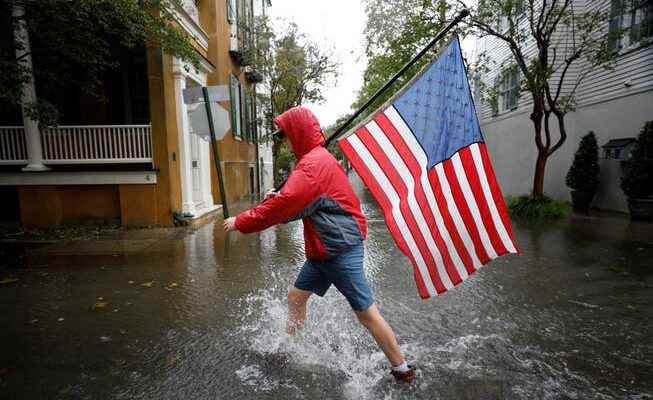After immense damage in Cuba and Florida, the hurricane moves further north. Several American states are on alert.
A Charleston, South Carolina resident rescued an American flag from the water and is crossing a flooded street with it after Hurricane Ian made landfall.
After hurricane “Ian” first caused enormous devastation in Cuba and then in Florida, it made landfall again at 2 p.m. local time near Georgetown in the American state of South Carolina. After some deceleration, it had regained speed over the Atlantic and had approached the coast at about 140 kilometers per hour. It was upgraded to a Category 1 hurricane again from Tropical Storm.
Many fatalities feared
The extent of the damage that “Ian” caused in Florida on Wednesday and Thursday with wind speeds of up to 240 kilometers per hour is only slowly becoming apparent, also because the rescue workers did not reach the crisis areas for a long time due to the flooding and strong winds. So far 700 people have been rescued.
On Friday afternoon (local time) there was talk of around twenty deaths, but hardly anyone doubts that the actual number is much higher. In Charlotte County on the southern west coast of Florida alone, where the hurricane made landfall, seven people lost their lives. Many residents had not followed the evacuation instructions.
“This could be the deadliest hurricane in Florida history,” said US President Joe Biden. He declared a state of emergency for the state of South Carolina. This instructed the federal authorities to support the local government and local authorities with relief and rescue work, as the White House announced. In a speech on Friday afternoon, the president said he was with the teams sent to Florida 3000 helpers It is the largest rescue operation in recent history.
Alarming harbingers
So far, Gov. Henry McMaster has not ordered any evacuations for South Carolina, but he has urged coastal residents to take precautions. Storm winds, heavy rain and flooding already hit Charlestown on Friday morning. The international airport has been closed. Experts assume that the states of Georgia, North Carolina and Virginia will also be affected by “Ian”. The US National Hurricane Center warned of life-threatening flooding, storm surges and strong winds.
Even before “Ian” even reached the country, the harbingers of the hurricane in the coastal town of Myrtle Beach caused storm surges of more than one meter in height on Friday afternoon and made the residents fear the worst for the further course. Streets and houses are flooded, shops and schools are closed, trees are falling and the electricity has already gone out for thousands of coastal residents.
Alligators in the streets
In Southwest Florida in particular, many people were confined to their homes. On Key Largo, one of the islands in the Florida Keys chain of islands in the very south of the state, the water in the streets is so deep that alligators are swimming in them, the newspaper “Miami Herald” wrote. The Coast Guard is constantly on the move with helicopters to rescue refugees from the roofs of houses. As of Friday, 2 million residents were still affected by the power outage and thousands are homeless because their homes were destroyed. The island of Sanibel is cut off from the mainland because of the destroyed bridge, some people are stuck there.
Florida Gov. Ron DeSantis said he expected high casualties and spoke of a disaster of historic proportions. Cities like Fort Myers are practically devastated. He warned that the danger was not over yet. In many places, the water is contaminated, which could lead to diseases and epidemics. Another danger lurks in defective gas and power lines. Most of the flooding has not yet subsided, and many Florida residents in life-threatening situations are still awaiting rescue.
Fitch Ratings estimates the insured losses caused by “Ian” alone at 25 to 40 billion dollars. That should completely destabilize the Florida insurance industry, which is already out of joint, and bankrupt homeowners. Many home insurers have gone bankrupt in the last two years. Those who remain often refuse to insure the many new buildings located near the water at normal conditions, or exclude flood damage from cover.
